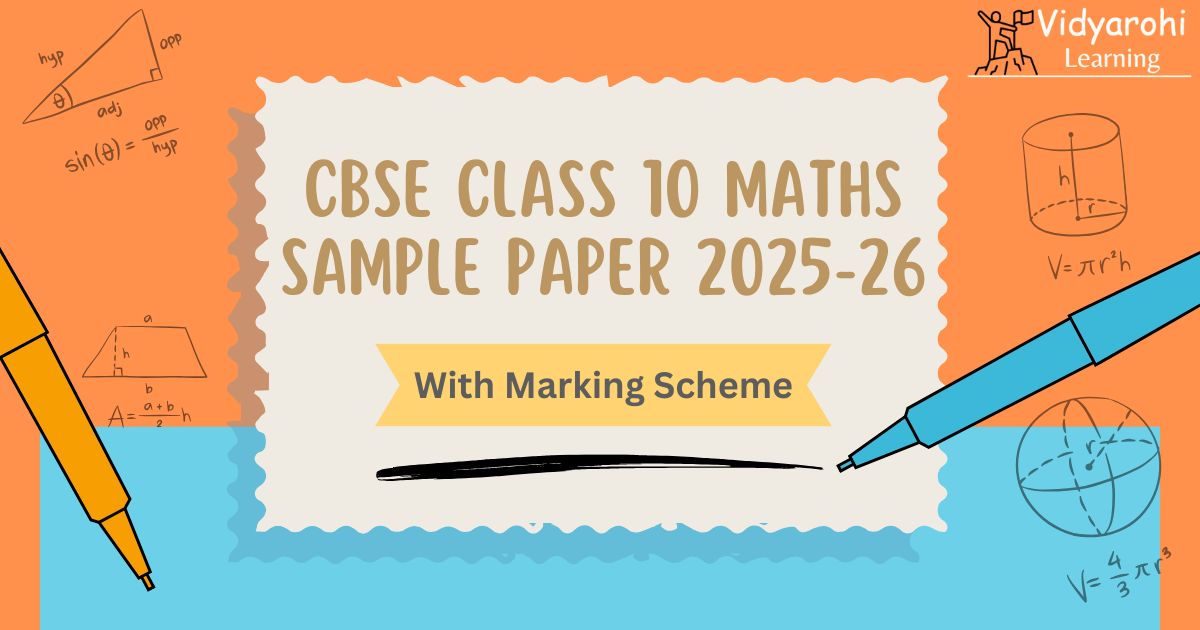CBSE 10th Mathematics Sample Paper: The Central Board of Secondary Education (CBSE) has officially released the Class 10 Sample Paper 2025-26 for both Basic and Standard Mathematics on its official website- cbseacademic.nic.in. The CBSE Class 10 Maths Sample Paper helps students understand the latest exam pattern, chapter-wise marks distribution, and difficulty level of questions. It includes all types of questions, such as very short answers, short answers, long answers and case study questions, similar to those asked in the actual board exam. CBSE also provides a marking scheme to help students learn how to write answers properly. This makes the sample paper a very useful tool for students who want to score well in Maths. In this article, you’ll find everything about the Class 10 Maths sample paper: how to download it, what’s included, and how it can help you in your preparation.
CBSE Class 10 Maths Sample Papers and Marking Scheme PDF
CBSE has recently released the Class 10 Mathematics Sample Paper and its Marking Scheme for the academic year 2025-26 on its official website. The board has continued with the same paper pattern as followed in the 2024-25 session. The sample paper includes 38 compulsory questions, divided into five sections: A, B, C, D, and E. Section A consists of multiple-choice questions (Q1-18) and two assertion-reason type questions (Q19-20), each carrying 1 mark. Section B includes very short answer (VSA) questions from Q21 to Q25, with each question worth 2 marks. In Section C, questions Q26 to Q31 are short-answer type, carrying 3 marks each. Section D contains long answer questions (Q32-35), with 5 marks allotted to each. Lastly, Section E features case study-based questions (Q36-38), each carrying 4 marks. There is no overall choice, but internal choices are provided in selected questions from Sections B to E.
You can find the direct download links for both the Basic and Standard Maths sample papers and marking schemes below.
CBSE Class 10 Maths Sample Paper 2025-26 (Standard)
CBSE Class 10 Maths Marking Scheme 2025-26 (Standard)
CBSE Class 10 Maths Sample Paper 2025-26 (Basic)
CBSE Class 10 Maths Marking Scheme 2025-26 (Basic)
CBSE Class 10 Maths Paper Format 2025-26
The CBSE Class 10 Mathematics question paper is structured into five different sections based on the types of questions and difficulty level, and contains 38 questions. All questions are compulsory, with no overall choice. However, internal choices are available within specific sections. The details CBSE Class 10 Maths Board Exam Pattern is given below:
| Section | Number of Ques | Marks/Qs | Marks | Type of Ques | Internal Choice |
| Section A (Q.1- Q.20) |
20 | 1 | 20 | MCQs, A&R | No |
| Section B (Q.21- Q.25) |
5 | 2 | 10 | VSA | 2 |
| Section C (Q.26- Q.31) |
6 | 3 | 18 | SA | 2 |
| Section C (Q.32- Q.35) |
4 | 5 | 20 | LA | 2 |
| Section E (Q.36- Q.38) |
3 | 4 | 12 | Case Study-based |
In all the 2-mark questions |
| Total | 38 | - | 80 |
Benefits of Solving CBSE Class 10 Maths Sample Paper
Solving the CBSE Class 10 Maths Sample Paper is one of the most effective ways to boost your board exam preparation. It not only helps students get familiar with the latest exam pattern but also builds confidence through regular practice. By attempting the sample paper in a time-bound manner, students can improve their problem-solving speed, accuracy, and time management skills. It also helps in identifying weak areas and understanding the right approach to writing answers, as per the marking scheme provided by CBSE. It offers several other benefits, some of which are listed below:
- Understand the Exam Pattern: Solving the sample paper helps you know the question format, types like MCQs or case-based questions, and the overall difficulty level.
- Practice Time Management: Attempting the full paper within the time limit improves your speed and helps you manage time better during the real exam.
- Find Weak Areas: Reviewing your mistakes helps you understand which topics need more attention and revision.
- Boost Accuracy and Confidence: Regular practice increases your accuracy and builds confidence for the final exam.
- Learn the Right Way to Answer: The marking scheme shows how to write answers properly to get full marks.
How to Use the CBSE 10th Mathematics Sample Paper Effectively?
Simply downloading the sample paper isn't enoug-using it the right way is key to scoring well in the board exam. To get the maximum benefit, students should treat the sample paper like the actual exam and follow a proper strategy while solving it. Here are some smart ways to use the CBSE Class 10 Maths Sample Paper effectively for better preparation and performance.
- Print the paper and solve it in one sitting of 3 hours, like a real exam.
- Set a timer and maintain strict exam-like discipline.
- Avoid looking at the marking scheme while solving.
- After finishing, evaluate using the official solution key.
- Highlight mistakes and note down weak topics for revision.
- Repeat this every 10-15 days to track your improvement.
CBSE Class 10 Maths Board Exam Preparation Strategy
Scoring well in the CBSE Class 10 Maths board exam requires a clear study plan and consistent practice. A well-structured preparation strategy helps students manage time, cover the entire syllabus, and focus on important topics. Below are some effective tips and strategies that can guide students to prepare smartly and confidently for the Maths board exam.
- Focus on NCERT textbooks and examples.
- Practice previous year board questions and sample papers side by side.
- Give extra time to units like Calculus and Vectors & 3D Geometry.
- Solve miscellaneous exercises from the NCERT after every chapter.
- Make a formula sheet for last-minute revision.
CBSE Class 10 Maths Syllabus 2025-26
The Central Board of Secondary Education (CBSE) has released the Maths Syllabus for Class 10 Science, Commerce, and Humanities (Arts) streams for the 2025-26 academic year. This Maths Syllabus outlines the course structure, chapters, and topics that students will need to study in the subject. The CBSE Class 10 Maths syllabus covers a wide range of topics, including Algebra, Geometry, Trigonometry, Mensuration, Statistics and Probability. It is divided into units with specific weightage, helping students plan their preparation effectively. The unit-wise chapters and weightage are provided below :
| Unit No. | Unit Name | Chapter | Marks |
| I | Number Systems | Real Numbers | 6 |
|
II |
Algebra |
Polynomials |
20 |
| Pair Of Linear Equations In Two Variables |
|||
| Quadratic Equations | |||
| Arithmetic Progressions |
|||
| III | Coordinate Geometry | Coordinate Geometry | 6 |
|
IV |
Geometry |
Triangles |
15 |
| Circles | |||
|
V |
Trigonometry |
Introduction To Trigonometry |
12 |
| Trigonometric Identities |
|||
| Heights And Distances | |||
|
VI |
Mensuration |
Areas Related To Circles |
10 |
| Surface Areas And Volumes |
|||
|
VII |
Statistics and Probability |
Statistic |
11 |
| Probability | |||
| Total | 80 | ||


